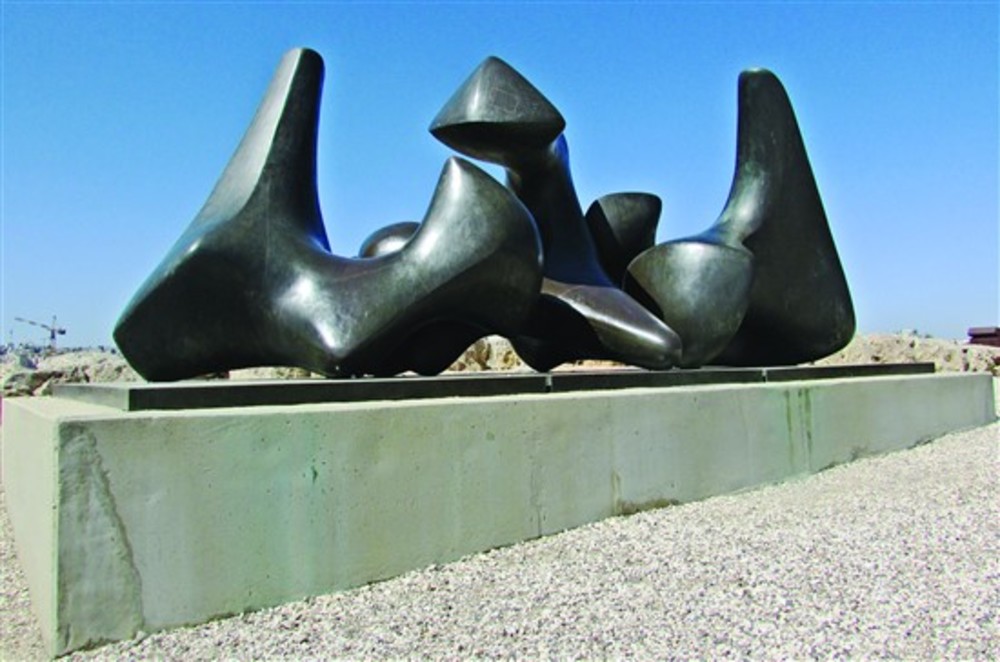Israel’s extraordinary sculpture garden
 Henry Moore’s three-piece figure entitled Three Forms: Vertebrae is just one of many sculptures in the Billy Rose Art Garden, designed by the Japanese-American sculptor Isamu Noguchi. /PHOTO | GEORGE M. GOODWIN
Henry Moore’s three-piece figure entitled Three Forms: Vertebrae is just one of many sculptures in the Billy Rose Art Garden, designed by the Japanese-American sculptor Isamu Noguchi. /PHOTO | GEORGE M. GOODWIN
I love sculpture gardens. America’s best known is the Museum of Modern Art (MoMA), which has the scale and ambience of a private dwelling. Its sculptures, including textbook examples by Rodin, Matisse and Picasso, and those by more perplexing upstarts, help form an urban sanctuary.
Another oasis is found within the sprawling and bustling campus of the University of California at Los Angeles (UCLA). Its Franklin Murphy Sculpture Garden more closely resembles a park. Swaying eucalyptus trees and shimmering pines shelter works by European and American masters. Some of my favorites reach skyward, hug the earth or dance in the wind. More profusely than MoMA’s Sculpture Garden, UCLA’s celebrates human strength and sexuality.
Southern California, an ideal place for the year-round, outdoor display of sculpture, boasts many other gardens, such as the Los Angeles County Museum of Art’s, the Norton Simon Museum’s and the Getty Center’s. But one surpassing all of these, as well as the Hirshhorn Museum’s in Washington and the Walker Art Center’s in Minneapolis, is Storm King Art Center. Far more than a garden or a park, this former country estate on the west bank of the Hudson, a few miles north of West Point, can be surveyed from multiple vantage points: across meadows, atop hills or up winding pathways. Many of Storm King’s best sculptures, forged from steel or carved from stone, are monumental in scale, brightly colored and unburdened by representation. Such American masters as Calder, Smith and diSuvero, whose works abound, could not have dreamt of a more heavenly setting.
Perhaps.
I believe that the Israel Museum’s Billy Rose Art Garden, in Jerusalem, constitutes an even richer and higher realm. Although I was astonished by it on two previous visits, in 1980 and 1985, I felt enraptured on my visit in March. Indeed, I also felt transported by experiencing portions of the museum’s vast but subdued architectural complex and by savoring a sliver of its 500,000-piece collection. But the garden, buildings and collection, established 50 years ago, form a historical, artistic and spiritual whole or epicenter, which, I believe, has few counterparts the world over.
So what makes the Israel Museum’s sculpture garden so special? Perhaps the most basic explanation is its setting. Only a few paces south of the Knesset, the garden offers sweeping views of Jerusalem’s western hills and valleys from its own ascending and descending elevations. Indeed, the garden’s brilliant stone, gravel and concrete design, by the Japanese-American sculptor Isamu Noguchi, may be his finest creation. Nature, however, has been his ideal collaborator. Trees, hedges, vines and flowers abound, as do sweet aromas. Spring felt ever-present.
Not only is the Israel Museum’s sculpture collection first-rate, each piece seems perfectly positioned to lead toward or away from its neighbor. Virtually all of my favorite old masters of modernism are well represented, from Rodin and Picasso to Moore and Marini to Calder and Smith. Many younger artists have also been selected, including a number of Jews (or artists with Jewish roots), such as di Suvero, Lewitt, Serra and Shapiro. Kadishman, probably my favorite Israeli sculptor, provides a visual fanfare with Suspense, which resembles a precarious Hebrew letter. There may be only a few women artists, but with his portrayal of a mother and a child consumed by agony, Lipchitz has made Jewish experience universal (and vice versa).
Far from being pedantic, however, the Billy Rose Art Garden can also be quite hip. Several stars of the international art scene are represented by new purchases and loans. A temporary environmental sculpture, Big Bambú, by Doug and Michael Starn, which had adorned the rooftop sculpture garden of the Metropolitan Museum in 2010, has been reconstructed here. As in New York, visitors are welcome to climb a curvilinear, thatched footway to its summit, then somehow find their way back to earth.
A new sculpture towering above all others is by Anish Kapoor, an Indian-born and London-based artist. A shimmering, 16-foot stainless steel column resembling an hourglass, it is placed on the museum’s highest and widest plaza, named for Ida Crown. This sculpture, Turning the World Upside Down, is both an abstraction and reflection of everything and everybody around it. Through light, it magically embraces, embodies and exemplifies Israel.
Amen.
GEORGE GOODWIN, a member of Temple Beth-El in Providence, has edited “The Rhode Island Jewish Historical Notes” for more than 10 years. An avid photographer, he took about 2,000 photos on his recent trip to Israel.







